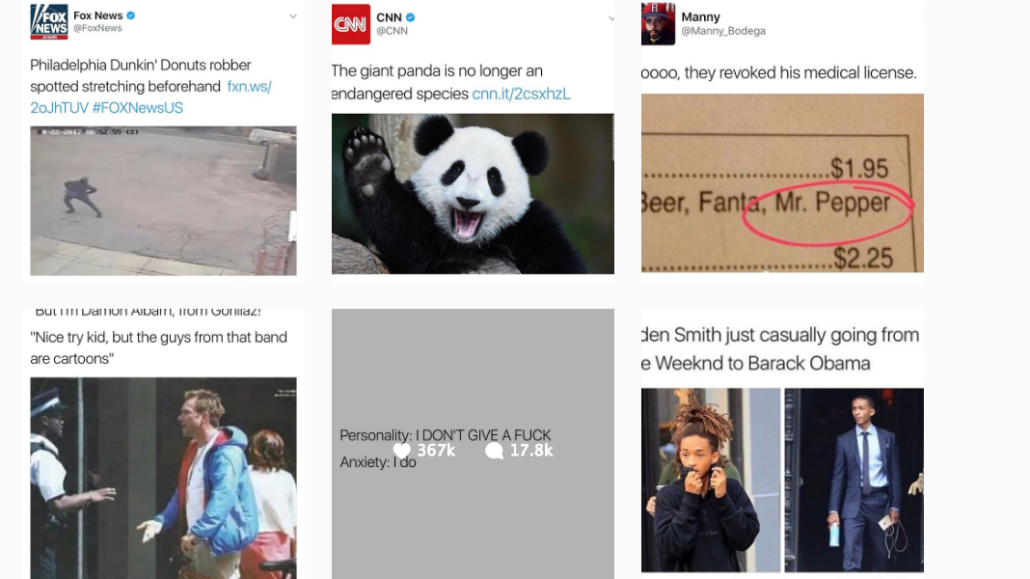Register by Jan 13 to save on passes and connect with marketers from Uber, Bose and more
FuckJerry: How a viral Instagram meme account became a marketing agency

When Elliot Tebele started aggregating memes and funny pictures with pal Elie Ballas on Tumblr in 2011, little did he know that his pastime would become a viral internet phenomenon on Instagram and beyond. Today, FuckJerry is not just an Instagram account with nearly 12 million followers but a full-blown social agency in its own right.
Since initially launching on Tumblr, FuckJerry has evolved into a franchise that includes an Instagram account, a clothing line, a card game, several social accounts like @pizza and @kanyedoingthings, a video channel and even a boutique social agency. Along the way, Tebele and his team have also been regularly criticized for plagiarizing and recycling other people’s creative material without attribution. But that hasn’t stopped all of these from coming together under the umbrella of Jerry Media, a 20-person shop that also manages social media accounts, runs influencer programs and does media-buying for other brands.
FuckJerry’s Instagram followers hit the 1 million mark in July 2014, and a month later, it ran its first branded post on its Instagram account, featuring Burger King’s latest offering, chicken fries.
“The 1 million mark was definitely a huge milestone,” Tebele said. “It was the turning point.”
Since then, it has applied its signature Seinfeld-esque brand of self-deprecating humor (the name FuckJerry came to Tebele while watching the show) and relatable memes to a string of other brands like Dos Toros and Jack in the Box.
“While we started in the realm of social and influencer marketing, we had an itch to turn everything we had into something even bigger,” said Mick Purzycki, CEO of Jerry Media. “We had a better grip on marketing than most people; we just had to build out our capabilities to facilitate that.”
The company has staffed up to help other brands create advertising that resonates with young consumers. Jerry Media has grown from four to 20 employees over the past year, hiring writers, designers, motion graphics specialists and media buyers. It has not abandoned its roots — Tebele, who continues to be the creative lead, heads a five-person team dedicated solely to memes.
“Memes are not only vehicles for comedy, but vehicles for having a differentiated voice,” said Purzycki. “It’s a unique format that demands attention from viewers, but is also highly adaptable to each specific brand.”
While Jerry Media produces a variety of content for its brands, memes still feature heavily in its creative strategy. For Mexican fast-casual chain Dos Toros, the agency created a new social mascot called Pinto the Burrito, who was brought to life on Instagram and, of course, through memes. The burrito appeared on everything from a reimagined Nirvana “Nevermind” album cover to an interpretation of Ken Bone as Ken “Pinto” Bone. The account has amassed over 147,000 followers over the past year and was also a Shorty finalist in the Instagram Presence category in 2017.
“Jerry Media felt like a perfect partner to inject humor, playfulness and on-trend jokes and memes into our social media voice,” said Leo Kremer, co-founder at Dos Toros. “We didn’t want to go in for the hard sell but rather create a digital mascot for the modern age that would be more like your funny, goofy friend.”
As an agency, Jerry Media monetizes not just through branded content, but also through the other agency services it provides, including production and media-buying. Purzycki said on average, posts can receive 6 million to 7 million impressions at a cost per 1,000 impressions of $2-$10. That means marketers can expect to pay at least $24,000 for a piece of sponsored content. He declined to share more details on pricing.
Moving forward, the company isn’t just sticking to the agency business. It plans to go “down the BuzzFeed route” and become a publisher, and is already beta-testing social news accounts called JerryNews. It declined to disclose specific revenue numbers, but said it expects to exceed $2 million in sales by December 2017.
“We have some serious plans in the coming years,” said Purzycki. “We want to be a media platform.”
More in Marketing

What does media spend look like for 2026? It could be worse — and it might be
Forecasts for 2026 media spend range from 6.6% on the lower end to over 10% but the primary beneficiaries will be commerce, social and search.

Pitch deck: How Amazon is emerging as the proof layer for TV spend
Amazon is positioning itself to advertisers as the “first-stop shop” for planning, buying, optimizing and measuring TV.

Here are the 2025 brand winners and losers of tariffs
Tariffs completely upended the retail industry in 2025 — and no company was left unscathed.








